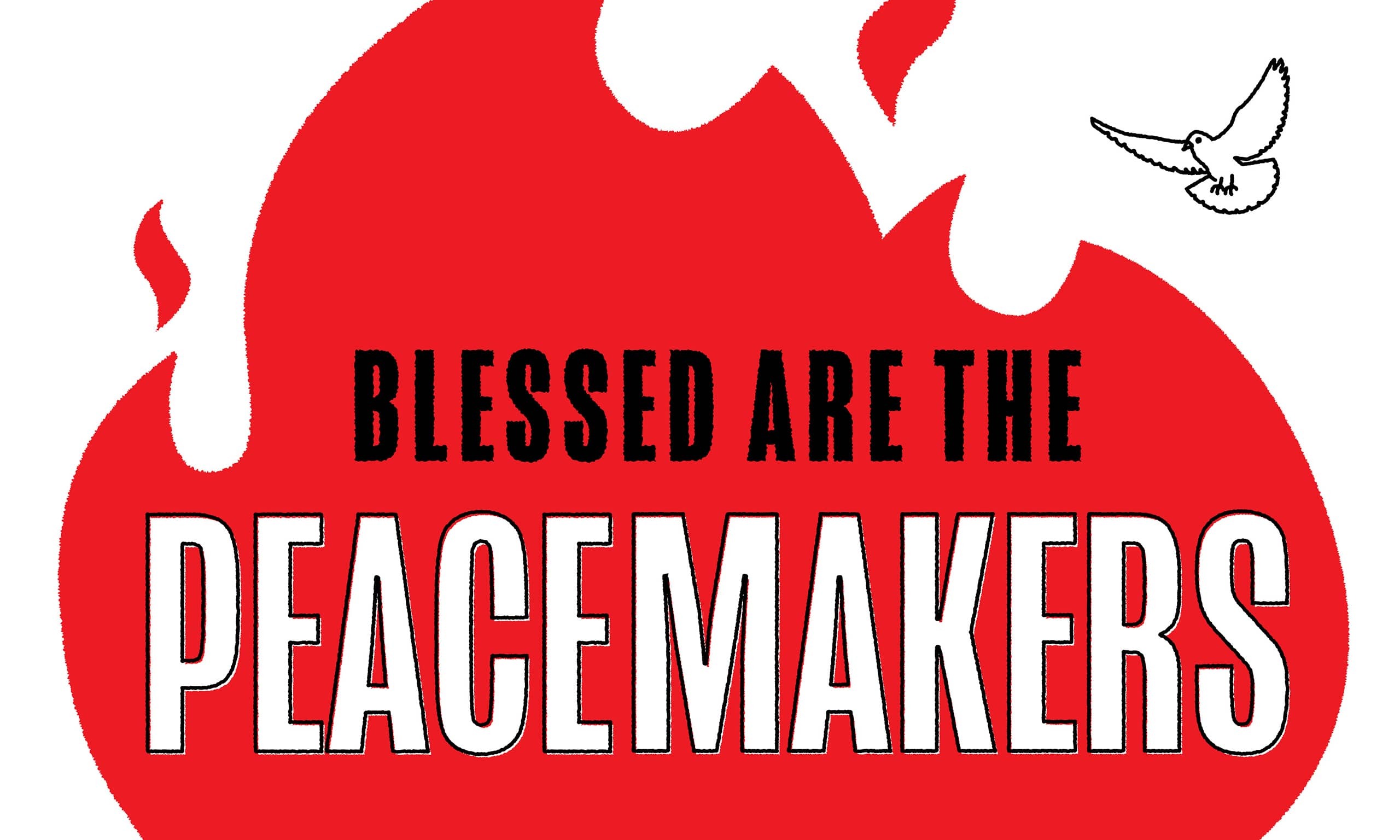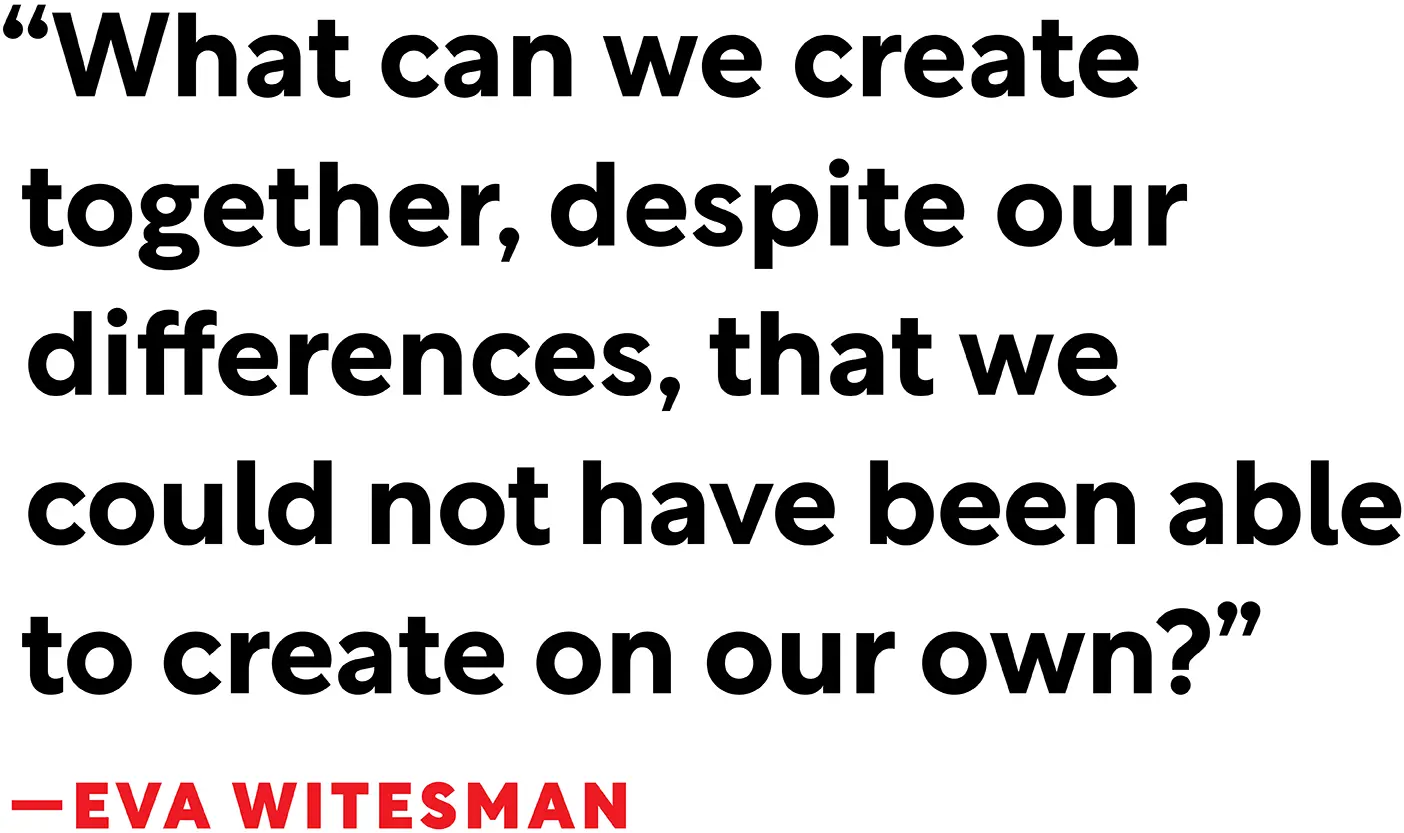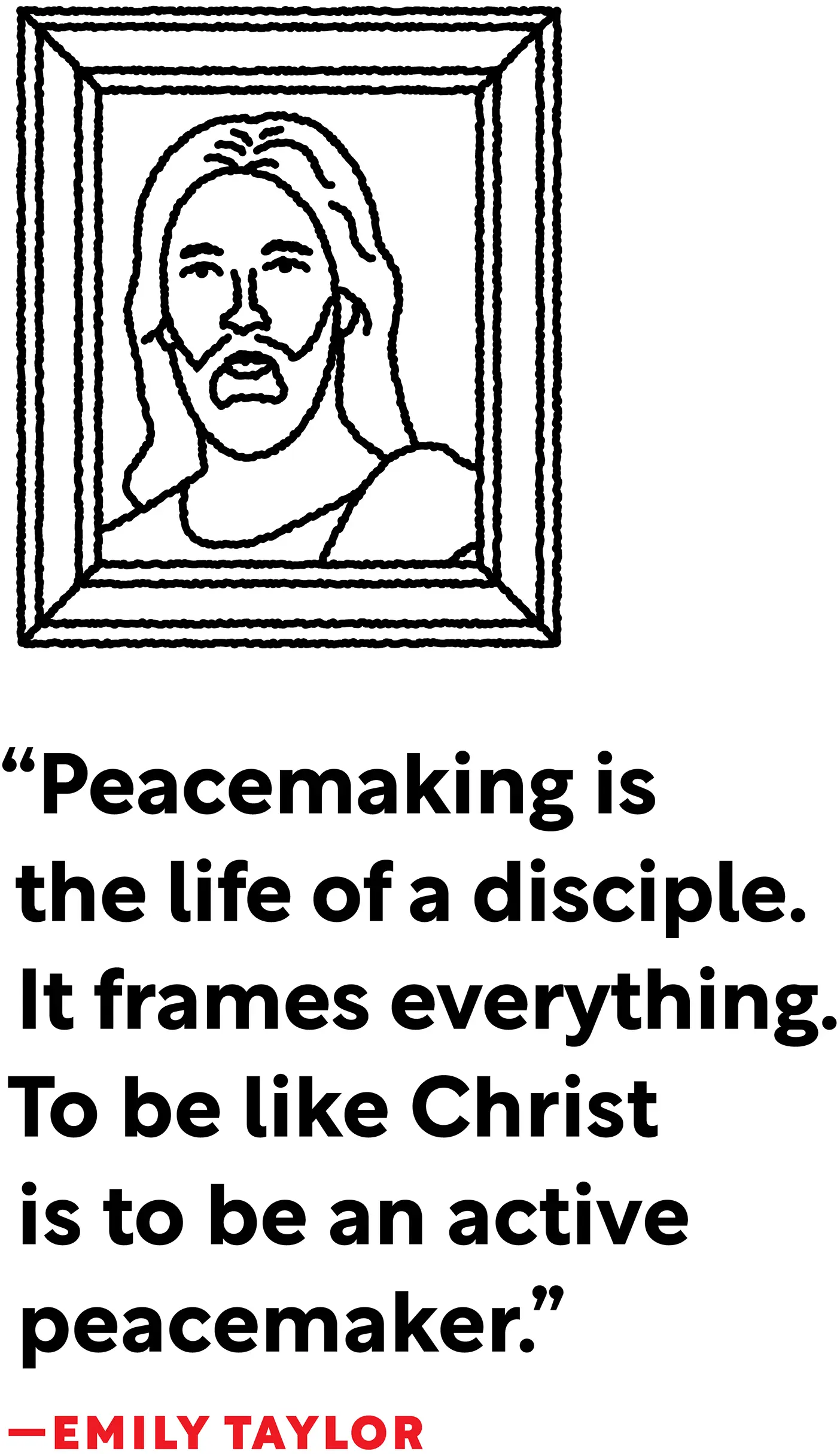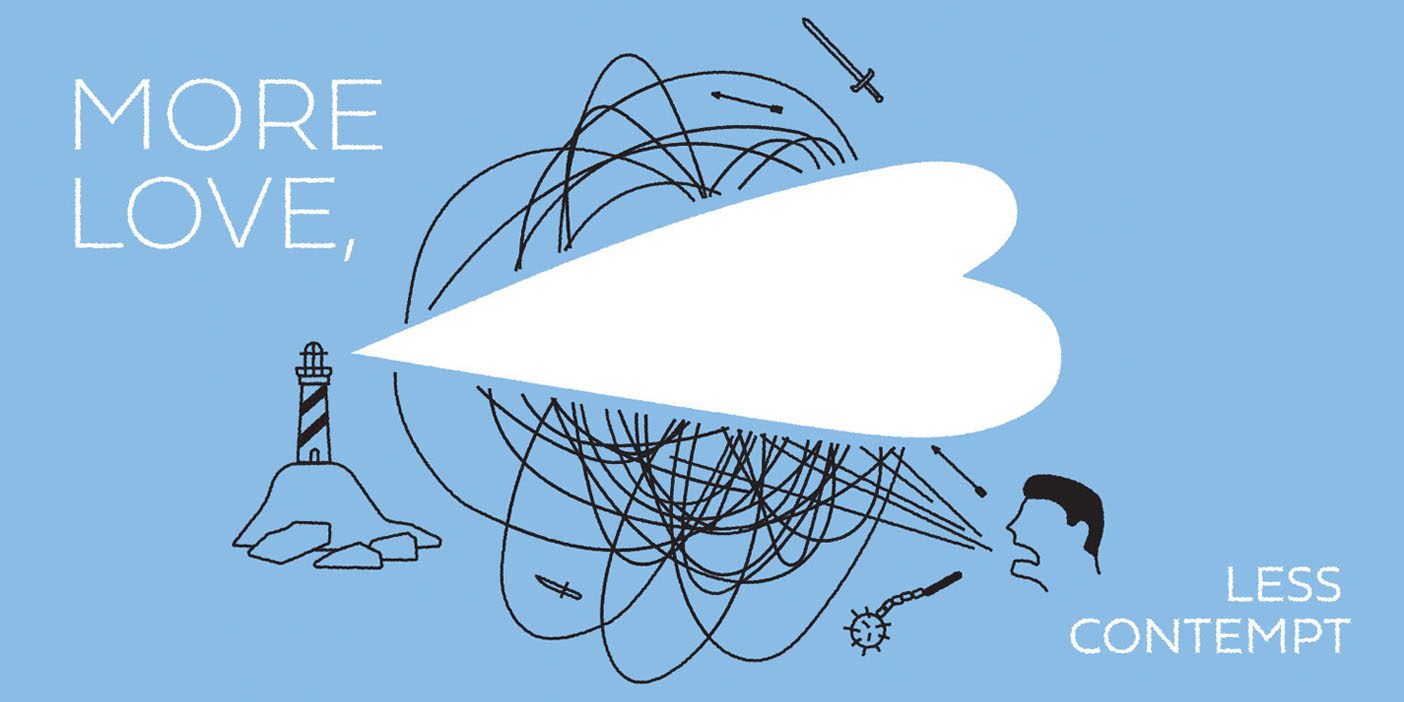Blessed Are the Peacemakers

BYU experts offer research-based and gospel-backed ways to disagree better.
By Sara Smith Atwood (BA ’10, MA ’15) in the Spring 2024 issue
Illustrations by Adam M. Johnson (BA ’07)
Eva M. Witesman felt nothing but fire. Burning red anger colored her thoughts, boiled through her body, urged her to impulsive, angry words. Witesman, now the director of BYU’s Ballard Center for Social Impact, had written an editorial for a local newspaper, sharing dearly held beliefs, and had just read a stinging rebuttal to her words in print. The response, she felt, entirely misunderstood and mischaracterized her views.
“I felt like I needed to do something, to engage and respond,” Witesman remembers. “Every time I sat down to figure out how, truly I would see red.” Eventually a thought broke through. How would Christ have her respond? She realized: “This is an opportunity for me to be the person that I want to become.”
So instead of penning a charged public response, Witesman wrote a private email inviting the author to lunch, humbly offering, “There might be things I have to learn.”
Both parties arrived at that lunch with apprehension—and left with an embrace. The conversation “didn’t completely convert me to her point of view,” Witesman notes, “but it created a bridge of peace, and I gained empathy for where she was coming from. She met me halfway, and together we turned rage into love.” These are skills Witesman now uses to address global and community problems.
In an increasingly polarized world, disciples of Christ, says Witesman, are poised to act as peacemakers. President Russell M. Nelson has called on Latter-day Saints “to interact with others in a higher, holier way, . . . to choose to be a peacemaker, now and always.”
BYU’s Center for Peace and Conflict Resolution—initially established to mediate conflicts between students and their landlords and now housed in the Law School, where it serves both campus and community mediation clients—is growing into a hub for faculty research and student education, a place to connect academic and spiritual thinking.
BYU Law dean David H. Moore (BA ’92, JD ’96) says that BYU has a key role to play “in a world that is rife with conflict”—from interpersonal disagreements to legal challenges to international strife. Here researchers “can combine academic study and the insights of the gospel of Jesus Christ to benefit the world in thinking about how we achieve peace.”
The good news is that, while disagreements are inevitable, we don’t just have to wing it, says Emily de Schweinitz Taylor (BA ’97, PhD ’24), former assistant director of the Center for Peace and Conflict Resolution and author of two books on mediation. “Instead of just going on all your intuition and prior experience, there’s research on what actually works,” she says.
Taylor, Moore, Witesman, and other campus experts offer research-based and gospel-backed approaches to engaging in conflict and finding ways to disagree better.

What Is Peace?
Turtles abound at BYU.
In Kristen DeTienne’s negotiations class, her MBA students take a conflict-mode assessment that assigns them one of five conflict “personality types”—sharks at one extreme, turtles at the other. “Sharks, they dig into conflicts, and they want to win,” DeTienne says. “Turtles . . . withdraw and say, ‘No conflict for me.’”

DeTienne says the “turtle profile is common at BYU,” and she helps her turtles understand “the difference between aggressive behavior and explaining your needs so you can advocate for yourself.”
Before earning a master’s degree in conflict resolution, Taylor also had strong turtle leanings and sees her BYU students hesitate to share thoughts they fear are too controversial. “Too often, for the sake of peace, we keep our mouths quiet,” Taylor says. “There’s a misconception in our culture that peacemaking means you remain silent.”
Peacemaking, she insists, isn’t stepping away, being quiet, letting things lie, bottling up feelings, or backing out of disagreements. “Peacemaking is not pacifism,” Taylor says. Peace is made; it is active and creative. Peacemakers, adds Witesman, are builders. “They’re actively building a vision of the world while also lovingly working with people who share a different vision of the world.”

Another belief Taylor once held: if she were “good and patient and did what was required,” she’d face no conflict. Not so, she learned. Conflict, it turns out, is a natural part of living with other humans. “Conflict [arises] when there are incompatible goals or [the] perception of incompatible goals,” Taylor says—two people or groups appear to want different things. That’s not something to feel bad about or be afraid of, she says. Contention, on the other hand, is different—and should be avoided.
“Contention is when you have hostile feelings,” notes Taylor. “The fact that there are incompatible goals stirs up very negative emotions. The Book of Mormon often describes people ‘stirred up to anger’—that’s contention.” Conflict arises everywhere—even among disciples. But Taylor says we can learn to keep from being contentious.
LeeAnn Glade (BA ’87, JD ’94), interim director of the Center for Peace and Conflict Resolution, and her law-student interns teach mediation clients that conflict can be a gift, “an invitation to deepen relationships, . . . an invitation to change” and create greater peace.
Witesman says conflict invites us to ask, “What can we create together, despite our differences, that we could not have been able to create on our own?”

Prep Work
If you find yourself retreating into your own turtle shell, it’s not without reason. American political discourse has become more divisive, featuring angry rhetoric and disappearing common ground. “Saying what you believe has become so treacherous [that] most people avoid it,” Taylor says. But we can’t solve anything if we can’t talk.
Taylor and communications adjunct professor Eliza Tanner Hawkins (BA ’89) say that learning to discuss differing views is key to building peace across divides. Both have been trained as facilitators with Braver Angels, a nonprofit offering community training in holding civil discussions between people with differing political viewpoints. The goal of such conversations, says Hawkins, “isn’t to change your core beliefs. The goal is to be able to talk with people and work with people even if you strongly disagree.”

Know Thyself (and the Other)
Start by remembering who you are—and by extending that grace to others, says Moore. “We really get into problems,” he says of political disagreements, “if we think of ourselves as Republicans or Democrats first, as opposed to children of God.” Elevating other labels, political or not, above that primary identity divides and obscures. “Heading into a divisive election year, we need to remember who we are and who everyone else is.”
That’s not to say that other identities don’t matter. Moore invites peacemakers to “experience other places and cultures,” befriending people of different backgrounds and faiths and reading a variety of news sources.
Witesman adds that the purpose of peacemaking, especially across ideological, religious, and political divides, isn’t sameness: “Peacemaking is recognizing the beauty in our diverse perspectives. . . . It also prevents us from believing that the only way we can have peace is if everyone is just like us. We were created in diversity. I think there’s a reason for that.”
What Do You Need?
Begin any conversation regarding conflict or disagreement by considering what you need from the discussion. What’s the goal of addressing the issue? Is there something you need the other person to understand, do, or change as a result? Taylor says to express that need directly: “Express a personal feeling, tag it with a need, and make a specific, concrete request.”
She gives the example of finding out her son wasn’t doing his math homework. She was tempted to just send a blunt text: “Do your homework.” Instead, she first communicated her needs: “I’m concerned that you’re not doing your math. I need to know that you’re fulfilling your school obligations before doing other things. Will you be sure to get your homework done first before you head out with friends tonight?”
Make Generous Assumptions
Approach disagreements with openness and optimism. Assume “that the other side has good intentions,” says DeTienne. Her recent research shows that assuming good intentions is more likely to lead to win-win outcomes—and to keep both parties on their best behavior.

As you ask questions and listen to the responses, be curious. “You might say, ‘Hey, I’m curious about what it’s like to live on the Arizona border with immigration from Mexico. I don’t have that experience. Can you tell me what that was like for you?” suggests Taylor. Ask follow-up questions, seeking to understand instead of to argue. “As people share, you don’t have to agree with them, but you may recognize the logic behind why they believe what they do,” Taylor says.
As they share, listen. “Don’t think about what you’re going to say next,” adds Hawkins. “You’re not trying to ask questions that trip somebody up or that prove a point. Instead, ask, ‘So how did you come to that view? Tell me more about why you think that.’”
Be Thou Humble
Listening to others with different perspectives requires vulnerability and an openness to change. Witesman stresses the importance of “being open to learning, . . . being humble, being willing to reexamine your beliefs with new information.”
And he says we should be on guard against defensiveness: “When our worldview is challenged directly, . . . the gut reaction is defense”—we build walls, verbally attack, and dismiss the other person. A better way: simply validate the other person’s experience and remember their dignity as a child of God. Wade into the discomfort and see what you can learn.
How to Disagree
When Taylor was 17 years old, her parents divorced. Soon after, she arrived at BYU and took a history class from Robert Cannon and Francine Russell Bennion, husband-and-wife team teachers. “They would argue together but in an intellectually honest way. It shocked me that you can have a good marriage and disagree about ideas.” Relationships, she discovered, can remain intact on the far side of a challenging discussion.
Once you’ve set the stage for peace, the next step is building it, one charitable and honest conversation at a time.
A Conversation Worth Having?
Not every disagreement needs to be addressed. When the topic isn’t important to you and the relationship isn’t close, it’s fine to avoid. For example, if your cousin wants to discuss a favorite political conspiracy at dinner, you might choose to step away rather than engage. In situations like these, Taylor pulls out her go-to line: “That’s a really tough topic. I don’t think I’m prepared to talk about that right now.”

If a situation becomes unsafe, it’s not worth having the conversation. If there’s intoxication or threats of violence, walk away. “If people are swearing, name-calling, or attacking, exit the conversation immediately. Same if they keep asking baiting questions,” Hawkins says. “These conversations are not meant for toxic situations.” Nor are they meant for abusive or unhealthy relationships, which are best mediated by a therapist.
Sometimes the outcome itself isn’t important to you, but maintaining a healthy relationship is. If your spouse insists on a restaurant that you wouldn’t have chosen, you can decide to accommodate and perhaps be the one to pick next time. “You don’t want to have a full mediation over what you’re going to eat for dinner,” says Glade.
Political psychologist Joshua R. Gubler (BA ’02), whose BYU research focuses on reducing prejudice, published a study exploring the discomfort that comes from having your lived experiences challenged. Based on that research he emphasizes the importance of recognizing that another’s experience may have something to teach us. “Approach with intellectual humility, based on our understanding of the limits of our lived experience, and signal that we are genuinely willing to listen,” Gubler says.
Ask Permission
Before you launch into a debate with a neighbor about the candidate on their yard sign or initiate a discussion with your spouse about their approach to discipline, Hawkins recommends pausing to ask for permission to engage. She suggests something like: “Can I ask you a few questions about your perspective? I’d really like to understand where you are coming from.” This approach, she notes, puts people at ease and signals that you aren’t there to force or mock or manipulate. And if the other person is not prepared to talk, you may need to schedule an important conversation for later—for example, after your spouse has a chance to decompress after work.
Don’t Debate a Straw Man
A discussion of differing views is a breeding ground for misunderstanding—willful or otherwise. “It’s easy to misrepresent someone else’s view and then argue with it,” Witesman says. Instead, check your understanding throughout the conversation by accurately rephrasing the other person’s points without passing judgment or intentionally exposing weaknesses.
Gubler recently published a study in which two people discuss a contentious issue online. As certain participants typed up their rebuttals, an AI bot offered ways to rephrase, using words like “What I’m hearing you say is . . .” The study showed that partners of participants who used the AI prompts better managed their anger and walked away from the interaction with more positive views of the other person. Those in conversations with partners who weren’t prompted to rephrase tended to remain angry and view the other as an enemy.

Mind the Temperature
It doesn’t take much for conflict to flare into full-blown contention. “Be really careful about anything you do that seems to be aggravating the situation or escalating the conflict,” says DeTienne. Her research shows that conflict can be cyclical, building on itself. “Aggravating behavior tends to escalate the conflict. Be careful about your part in that.”
If you feel your heart rate rising, if you’re feeling emotionally unable to converse respectfully or are feeling attacked, Witesman says it might be time for a break. “In the heat of the moment, it’s good to take a pause and step back,” she says. You might need some physical space or to take a minute to mentally gather yourself before continuing.
Taylor suggests making a plan for when, not if, you start to feel heated. “It takes three seconds to go into fight or flight and about 20 to 30 minutes to come back down,” she says. Get a drink, take a walk, or sleep on it.
When a conflict becomes contentious, Glade encourages apologizing in the moment. She recommends starting with something like, “Now I’m saying things that aren’t reflective of my goal. Can we start this again? I’ve said some things I need to apologize for.”
“I have five teenagers,” adds Taylor. “There’s a lot of saying sorry going both ways.” She can’t think of a better way to teach her kids about repentance than by showing “that I need it too.”
When apologizing, Taylor recommends being specific. “General apologies, not followed by an attempt at restitution, demonstrate that the relationship is not important to you,” she says. “If it’s a severe hurt, assume that it’s going to take some time to repair.”
Sometimes you are the injured party. “Forgiveness is peacemaking,” says Witesman. “Forgiveness doesn’t mean permission or access to hurt me again or that I now agree with your viewpoint. Forgiveness sets down the burden of anger and pain and allows the Savior to handle those things, freeing you to be a peacemaker and to have empathy.”

Add Insight
“Sometimes we want to stop after we’ve listened to the other side,” Taylor says. “Give yourself a chance to have an exchange—we need more of that. Peacemakers don’t just listen.” Explain your viewpoints and perspectives. This isn’t your time to refute everything you just heard; speak to be understood, rather than to argue or disprove.
Law student Jenneka Lindorf Austen (BS ’99, JD ’24), a mediator at the Center for Peace and Conflict Resolution, says speaking to understand and be understood—rather than to persuade—opens hearts. “When someone feels like you’re just trying to persuade them, they’re going to resist. But when people feel understood, they’re way more likely to come your way and find resolution, oddly enough.”
Hawkins suggests using “I statements.” For instance: “I’m worried about what’s happening to the Great Salt Lake,” rather than, “If you don’t stop using so much water, the Great Salt Lake is going to dry up.” Use phrasing such as, “from my perspective,” “I see it this way,” and “in my experience,” rather than presenting your side as the absolute truth. “Mention areas of agreement if you see them,” she adds. “Share life experiences and personal stories.”
Seek a Resolution
With some conversations the goal may simply be to reach a better understanding of another perspective. But others demand a concrete resolution: a work meeting where you and a coworker decide on a direction for a project, a discussion with your spouse about discipline approaches, or settling on a chore rotation with roommates.
Compromise, Compete, or Collaborate?
Many conflicts are resolved by choosing to split the outcome 50/50 or come up with some other give-and-take solution. DeTienne describes disagreeing about the placement of a fence her neighbor wanted to build. She decided what needs were important for her to hold—she didn’t want the fence to block a walkway—and what she was willing to compromise on.
But competing for your interests can also be appropriate. “Sometimes disciples should compete,” says Taylor. “Competing means you stand up for the thing that matters to you. It doesn’t mean you need to be contentious.” She offers the example of a time she bought a used car. “I wrote out a script, and I thought about what the salesperson was going to say. It felt like I was acting at first, but I can’t tell you how empowering it was to stand up for my needs in a respectful way to the other person and see that it actually worked.”
Often, it’s possible to find a way to collaborate to find a mutually beneficial outcome. In her negotiations class DeTienne teaches her students how, with a little creativity, they can grow the metaphorical pie they are trying to divide, with room to largely meet everyone’s needs. “We work together to build the pie so there’s more for both of us. I might be able to give you 98 percent of what you want and still get 98 percent of what I want.”

Common values are “your clue to solutions,” says BYU political scientist Kirk A. Hawkins (BA ’93, MA ’95), who is married to Eliza. “To give an example, if you’re talking about immigration with someone you disagree with, after sharing your viewpoints you might get to a place where you can say something like: ‘It sounds like we both value the rule of law. Any solutions we have here should really respect that.’”
Conversing in this way shows “you’re willing to not see the other person as an enemy,” adds Eliza Hawkins. “Then you’re able to work together and come up with a third way”—exploring solutions that get at the concerns and motivations behind opinions, which might not be obvious until they are respectfully discussed.
“It’s not persuading you to change your mind,” adds Witesman. “It’s persuading you that I might actually be an asset with a view that you don’t have and that together we can come up with better solutions.”
Get Creative
As an intern at the Center for Peace and Conflict Resolution, law student Angela Cothran (BA ’21) helps parties brainstorm possible solutions. She tells them there are “no bad ideas—let’s just get as many ideas out as we can.” And once they can’t think of any more solutions, they discuss and decide on one to try. If the first idea doesn’t work, they have a long list to go back to.
Glade teaches her clients to use the language of possibility when seeking solutions: “Instead of saying, ‘We have to,’ or, ‘We need to,’” she suggests looking to the future with questions like “What would be possible?” or “Would you consider this?” or “Moving forward, would this work?”
And Glade points out the powerful role prayer and inspiration can play in resolving conflict. “Listen for the promptings of the Spirit,” she says. “Heavenly Father has knowledge of both of you and insights that we don’t have about ourselves. That’s powerful.”
The Prince of Peace

The walls of the Center for Peace and Conflict Resolution are a tranquil blue, accented by a calming water feature and a line of black-and-white photographs of some of the world’s greatest peacemakers: Nelson Mandela, Martin Luther King Jr., Mother Theresa, and others—alongside a portrait of Christ, the Prince of Peace.
Taylor becomes emotional remembering when Rima Salah, a Palestinian woman who led a distinguished career with UNICEF, visited the office in 2021 to receive the center’s Peacemaker Award. Pointing to the photographs, Salah said: “The world has all of these.” Then, gesturing to the portrait of Christ, she added: “And you have Him.”
Indeed, in their research and teaching, BYU experts look to Christ and His gospel as the model for peacemaking. Gubler cites a favorite scripture: “How beautiful upon the mountains are the feet of him that . . . publisheth peace” (Isa. 52:7).
For Christ, they note, publishing peace involved going against cultural norms that could hinder peace—talking to Samaritans, healing on the Sabbath, associating with lepers and tax collectors. When there was a need, Christ acted by building bridges of peace and interacting with solemnity and calm assurance rather than anger or degrading remarks.
Standing for peace takes courage, says Taylor, courage that Christ modeled as He made peace on earth with divine dignity. “Peacemaking is the life of a disciple,” Taylor adds. “It frames everything. To be like Christ is to be an active peacemaker.”

Feedback Send comments on this article to magazine@byu.edu.





